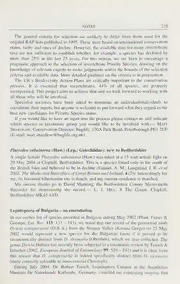
Platyedra subcinerea (Haw.) (Lep.: Gelechiidae): new to Bedfordshire PDF
Preview Platyedra subcinerea (Haw.) (Lep.: Gelechiidae): new to Bedfordshire
NOTES 225 The general criteria for selection are unlikely to differ from those used for the BAP original lists published in 1995. These were based on international conservation status, rarity and rates of decline. However, the available data for many invertebrate taxa are not sufficient to establish whether, for example, a species has declined by more than 25% in the last 25 years. For this reason, we are keen to encourage a pragmatic approach to the selection of invertebrate Priority Species, drawing on the knowledge of relevant experts to make judgments within the bounds of the selection criteria and available data. More detailed guidance on the criteria is in preparation. The UK’s Biodiversity Action Plans are critically important to the conservation process. It is essential that invertebrates, 44% of all species, are properly incorporated. This project aims to achieve that and we look forward to working with all those who will be involved. Specialist societies have been asked to nominate an individual/individuals to coordinate their inputs, but anyone is welcome to put forward what they regard as the best new candidates for Priority Species status. If you would like to have an input into the process please contact us and—indicate which species or taxonomic group you would like to be involved with. Matt Shardlow, Conservation Director, Buglife, 170A Park Road, Peterborough PEI 2UF (E-mail: [email protected]). Plcityedra subcinerea (Haw.) (Lep.: Gelechiidae): new to Bedfordshire A single female Plcityedra subcinerea (Haw.) was taken at a 15 watt actinic light on 29 May 2004 at Clophill, Bedfordshire. This is a species found only in the south of the British Isles and believed to be in decline (Emmet, A. M., Langmaid, J. R. et al 2002. The Moths and Butterflies ofGreat Britain and Ireland 4 (2)). Interestingly for , me, its favoured hibernation site is thatch, and my current residence is thatched. My sincere thanks go to David Manning, the Bedfordshire County Micro-moth — Recorder for determining the record. L. J. Hill, 8 The Green, Clophill, Bedfordshire MK45 4AD. Lepidoptera of Bulgaria - an emendation In our earlier list of species recorded in Bulgaria during May 2002 (Plant, Fraser & Gorman, Ent. Rec. 115 131 - 143), we noted that our record of the geometrid moth : Dyscia conspersaria (D.& S.) from the Struma Valley (Kresna Gorge) on 25 May 2002 would represent a new species for the Bulgarian fauna if it proved to be taxonomically distinct from D. sicanaria (Oberthtir), which we also collected. The genus Dyscia Hiibner has recently been subjected to a taxonomic review by Trusch & Erlacher (2002. European Journal ofEntomology 99: 529 - 541 ) and it is clear from this review that D. conspersaria is indeed specifically distinct from /). sicanaria (more correctly referable to innocentaria Christoph). During July 2004, Dr. Robert Trusch, Lepidoptera Curator at the Staatliches Museum fur Naturkunde Karlsruhe, Germany, e-mailed me expressing surprise that
